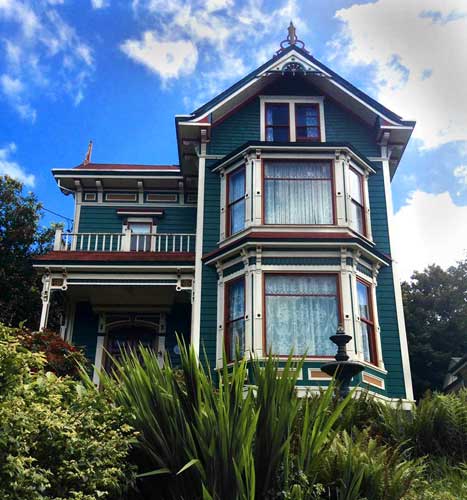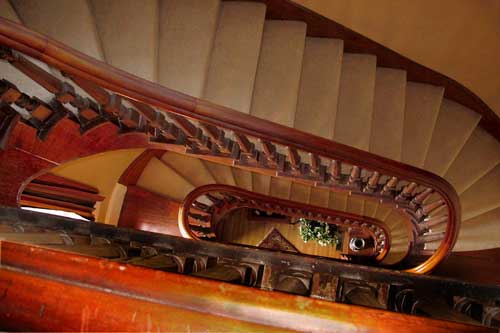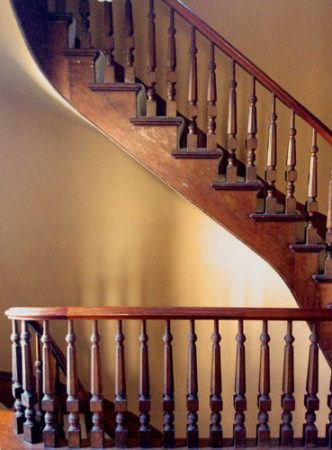 Katie Rathmell has a Master’s degree in marine science and was working for Oregon Health Sciences University when she decided to switch to historic preservation as a career.
She first became interested in historic preservation when she bought a historic house in California that she called “a fixer upper” which she restored. Katie attended Clatsop College’s Historic Preservation degree program and after graduating from the program, started a business called “Pacific Window Restoration” which specializes in the restoration of wood windows in historic homes and buildings. Katie believes in “the value of preserving the craftsmanship and resources that were employed in early buildings and homes. It is our mission to preserve and restore, making the old new again. Sustainability through restoration is our standard.”
Katie Rathmell has a Master’s degree in marine science and was working for Oregon Health Sciences University when she decided to switch to historic preservation as a career.
She first became interested in historic preservation when she bought a historic house in California that she called “a fixer upper” which she restored. Katie attended Clatsop College’s Historic Preservation degree program and after graduating from the program, started a business called “Pacific Window Restoration” which specializes in the restoration of wood windows in historic homes and buildings. Katie believes in “the value of preserving the craftsmanship and resources that were employed in early buildings and homes. It is our mission to preserve and restore, making the old new again. Sustainability through restoration is our standard.”
 I met Katie on the recommendation of a local historic homeowner, because I was looking for someone to preserve my historic windows and do other specialized preservation work for my house in Astoria. My house on Grand Avenue has been an ongoing fascination for me for several years and always will be. I was teaching in Astoria a few years ago and saw the house five times before finally deciding to purchase it. The house, an elegant Queen Ann, was built in 1886 by Albert Ferguson and his youngest son, James Ernest Ferguson.
I met Katie on the recommendation of a local historic homeowner, because I was looking for someone to preserve my historic windows and do other specialized preservation work for my house in Astoria. My house on Grand Avenue has been an ongoing fascination for me for several years and always will be. I was teaching in Astoria a few years ago and saw the house five times before finally deciding to purchase it. The house, an elegant Queen Ann, was built in 1886 by Albert Ferguson and his youngest son, James Ernest Ferguson.
Albert was a carpenter and architect who built many houses and state buildings in Salem and Astoria. He designed and built Astoria’s first city hall in 1878 and the Capt. J.J.D. Gray House. By the time he was able to design what we assume was his “dream home” it was the late 1880s and he was suffering from rheumatoid arthritis. So Albert worked with his son James on the house’s design and both had a major hand in creating the magnificent house. He died in 1891, only four years after the house was completed.
The Grand Avenue house was owned by the Ferguson family until the late 1930s. Albert Ferguson was a very good friend of the famous Captain George Flavel, who built and owned the Flavel house, a famous local landmark, and helped to develop the town of Astoria.
With its magnificent 11 foot ceilings, detailed wood designs, rare tin ceiling in the parlor and original hardware and light fixtures, the expertise of both Fergusons shines in the home and a wraparound three level staircase creates a center for the unique 4,000- square foot house. The house was listed in the National Register of Historic Places in the 1980s.
The staircase, which twists and turns like a beautiful snake, wraps around to the third floor and offers a view of each level on its journey to the top.

Katie worked last summer on the staircase which she says is in “remarkable shape” for its almost 130 years. The staircase is made of reddish mahogany which must have come from some long-ago rain forest. One assumes the wood for the staircase was especially ordered by the Fergusons many months before the house was built and they could have waited for it to come by ship across the water from ports beyond to build their staircase.
The staircase is amazing, a work of art. Most people use machines nowadays and run the wood through shapers, but this kind of hand created craftsmanship is really a lost art.
 The finish on the staircase was cracked and there were some spots where dry rot was entering. Katie hand-sanded it down to get off the old finish and most of the work she did followed an old- fashioned method that might have gone back to the time the house was built or even further. Using a mixture of linseed oil soap and boric acid, she cleaned the balusters, no small feat given how many balusters there are! Her method is popular in Sweden and with historic preservationists, and the mixture she uses acts as both a wood conditioner and also prevents mildew. Modern compounds such as caulking and latex paint are destroyers of old wood. After treating the wood, she applied two light coats of varathane on the handrail and used linseed oil wax on the balusters and newel posts. She recommended that we repeat the procedure every six months or so to keep the staircase in good shape.
The finish on the staircase was cracked and there were some spots where dry rot was entering. Katie hand-sanded it down to get off the old finish and most of the work she did followed an old- fashioned method that might have gone back to the time the house was built or even further. Using a mixture of linseed oil soap and boric acid, she cleaned the balusters, no small feat given how many balusters there are! Her method is popular in Sweden and with historic preservationists, and the mixture she uses acts as both a wood conditioner and also prevents mildew. Modern compounds such as caulking and latex paint are destroyers of old wood. After treating the wood, she applied two light coats of varathane on the handrail and used linseed oil wax on the balusters and newel posts. She recommended that we repeat the procedure every six months or so to keep the staircase in good shape.
Owning the Grand Avenue house has opened my eyes to the beauty of historic houses. So much of that individual design and craftsmanship can be found in the vintage hardware, elegant pre-electric lights and amazing hand-carved woods. These houses are unique and custom built reminders of the past. Every time I see a historic house with sagging windows, peeling paint and rotting sides, I feel sad, knowing that the heritage of these houses is slipping away slowly in neglect. It is people like Katie who are the heroes of the historic house preservation world. In an age of instant and easily obtainable, they are the ones who painstakingly take the time to learn how to preserve the past so that these houses can continue in the future and not be gone and forgotten.

